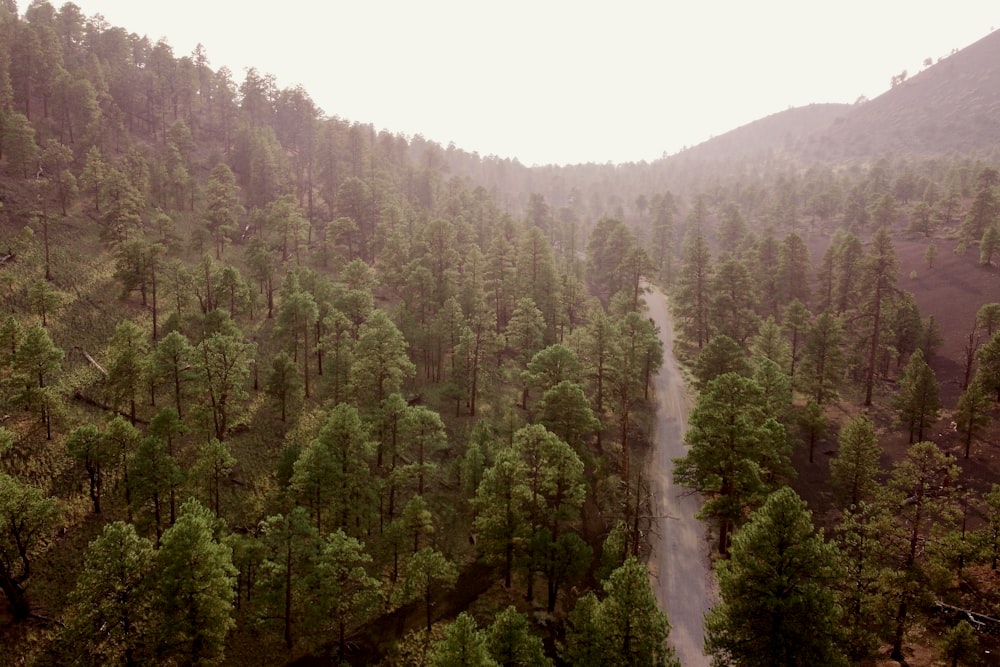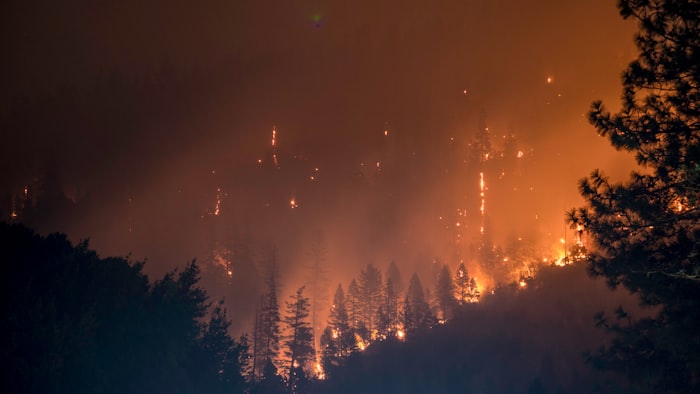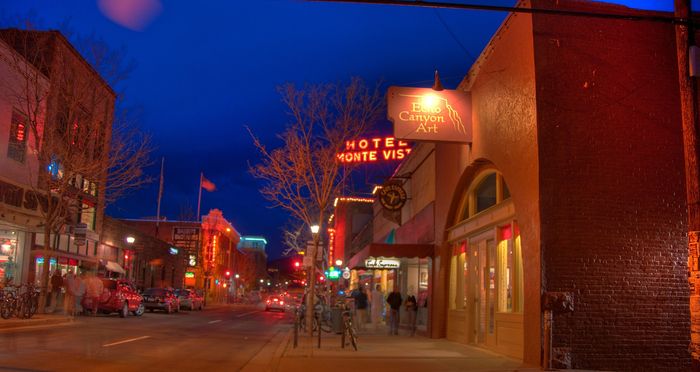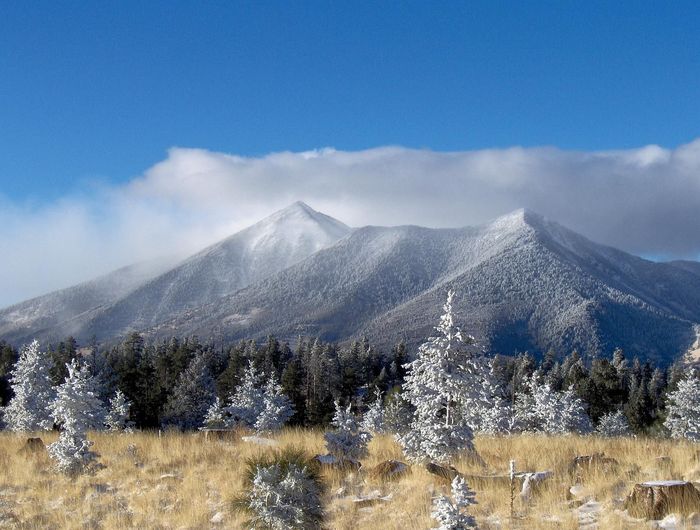It is a Friday night, and we are at a friend’s house about to play a board game. I am notoriously mistrustful of games, especially those that involve a board; that I am going to play Settlers of Catan is a result of skilled manipulation. Derek planned this dinner and game night but only told me about the tacos; I am a sucker for Mexican food and Derek uses this knowledge skillfully and shamelessly to get me out of my comfort zone, which is one of the reasons I love him. I eat too many tacos and feed bits of tortilla to the dog, who is equally susceptible to being tricked by treats.
Our bodies make the living room grow warm as Mike and Trica, an outdoorsy, organized couple who recently moved to Flagstaff from the Northeast, take turns talking over each other. Tricia interrupts Mike to warn us that Mike always wins. He’s merciless, she says, pushing her eyes so wide that her eyelashes kiss her blonde brows; be careful. Mike stretches his beanpole body away from the table and rolls his eyes, telling us that Trica is just bad at Catan and a notorious sore loser. Derek belches without covering his mouth and goes to get a third helping of tacos.
The explanations continue. As usual, the rules of the game sound overly complex. I feign interest and promptly forget all of the instructions. Mike gets everyone another beer and a tiny square of overpriced, fair-trade dark chocolate that is so bitter I gulp beer to wash the bite away. The board sits in front of us, colorful hexagons and little house-shaped pieces littered across the table. Mike is still talking but for the life of me, I can’t remember a single rule. Once we start to play, however, I catch on quickly, and am soon a terrifically ruthless competitor.
Put simply, the point of the game is to spread your little house and road bits across the board-world in order to control as many hexagonal plots of land as possible. The more of your plastic pieces that you spread across the world, the more powerful you are. As always, power is what we are supposed to want above all else.
Each hexagon contains a commodity that can be used to develop your “settlements”. Players roll the dice in an attempt to collect resources, and the more resources you gain, the more settlements you can develop. There are also cards that hold unpredictably valuable resources and lots of interesting snags that can set back an unlucky player. Other ways to gain points include collecting ‘knight’ cards, which can collectively form a standing army reserve; building the longest road, regardless of where it goes; developing smaller settlements into larger cities; robbing, hoarding or blocking resources; alternatively, forming short-term non-binding alliances, and more. Settlers of Catan is simple: control the resources, gain points, and win the game.
As we play, I am struck by two things: one, I am having fun, and two, this game is undoubtedly the purest embodiment of a Western-centric relationship to landscape I have ever experienced. That’s the intention, of course; when Klaus Teuber invented the game in 1995- released first in Germany, and the following year in the state- he was heavily influenced by multiple well-known economic theories, such as price theory, threat point and zero-sum game (Raphel). These theories are widely employed in the international relations realm, and Teuber has developed a game that puts these ideas into action with an almost-eerie effortlessness. Catan is one of the most popular board games of all time, and I’m beginning to understand why. The dog settles down at our feet, bored with our human delight; she has a different definition of a good time.
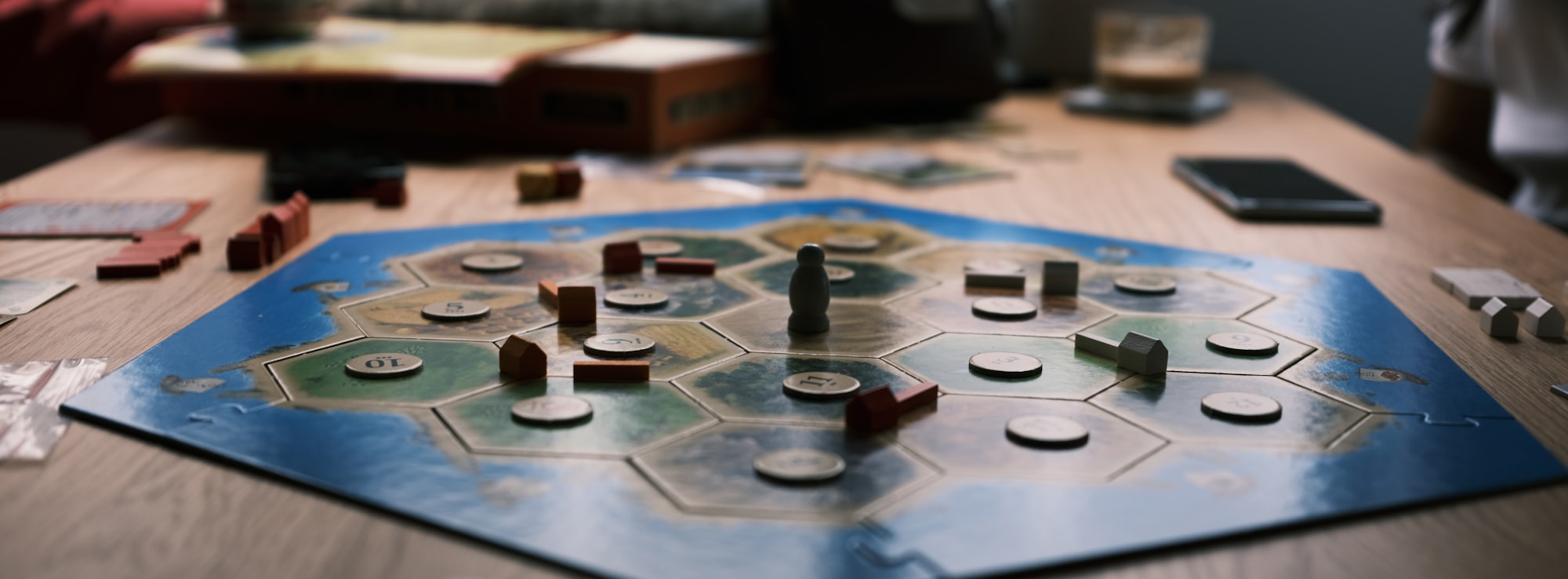
I rake the dog’s fur with my bare toes and get into the rhythm of the game. I am scheming, plotting for control, maneuvering for more. I watch Derek spread his reign across the grasslands where my sheep were meant to graze; I feel Mike’s attention on the iron-rich landscape to the left of my meager settlement. I imagine wind beating against the small plastic roofs while these unwelcome forces press in from either side.
Across the board, against the far ocean, Tricia has access to only one field of wheat and an empty desert, where nothing will ever grow. If one of her sheep wandered too far, it would surely turn to a bleached set of bones before long. I knew we should have been neighbors; now there is no way to fight the will of these men, our beloved enemies whose rules we have no choice to accept. I smile with thin lips and trade in my small hut for a castle, doubling my resource intake with each turn.
Fun aside, the implications of Settlers of Catan are hard to ignore. Your choice of placement and movement on the board-landscape has nothing to do with what these ‘places’ might look like, smell like, feel like. The point is not to imagine or engage with the landscape, but to use it. Hexagons, or regions, are understood to be valuable as commodity, not as community. Land is not home but highway, a stepping-stone to gaining more points- invisible, intangible points that are valuable only within the construct of the game. Spiritual connection to place is laughable; that the players understand land as possession and as a means to an end is a basic premise of the game.
For the rules of Catan to seem so obvious to us is a product of more than just an impeccably designed and engaging board game. Those born in a world in which developed western nations stand as entrenched hegemons- particularly those of us born within those powerful western nations, like the U.S.- have been comfortably indoctrinated with such economic philosophies since we slipped out of the womb onto a hospital bed that costs X dollars, with a doctor whose services cost Y, in a hospital that makes Z amount of revenue on you as a consumer. We laugh at how eerily accurate this game mirrors Western expansion and the practice of commodification; I want to keep talking about this, but I need to focus on blocking any expansion of Derek’s access to a trading port near my town. I protect my settlement and gain more sheep than I know what to do with, and toy with the idea of a new city.
At the inception of the United States experiment, our relationship to land was grounded in the idea of Earth as a vessel to serve mankind, bestowed by a largely Christian God who has created man in his own image.
[1:26] Then God said, "Let us make humankind in our image, according
to our likeness; and let them have dominion over the fish of the sea, and
over the birds of the air, and over the cattle, and over all the wild animals
of the earth, and over every creeping thing that creeps upon the earth.
In addition to this vision of land as a divinely gifted human possession, the ‘founding fathers’ employed social contract theory from Locke and Hobbes- recall Hobbes’ description of life without society as “nasty, brutish and short” as a foundation for the U.S. constitution. In this way, the idea of Man versus Earth was written straight into the documents that birthed the U.S. government- and directly into the hearts of the descendants of the white European settler, who are today, the “American people.”
They shouldn’t have understood
those Biblical words that way
and become simple as death.
And, finally, complex liars
And thieves. (Ortiz, 51)
***
Within three turns I have completely abandoned my instinct to be drawn to a place by instinct or aesthetics; the hexagons transform from living earth into math equations, and I add miles to my road, headed towards the forest. Mike already has the longest road, but I need lumber, if I want to build another settlement. Tricia is, as predicted, losing by an impossible amount and she starts waving her cards in the air, offering wheat to anyone who might need it. Derek makes a grab for them, but I am quicker, like always, and I grin into my new assets and pour the rest of the beer down my throat.
Mike glares at Tricia because she is not being loyal to him when she gives her cards to anyone else. He brings us all water, including a bowl for the dog, which she laps up loudly, spraying the kitchen floor and turning the ground into a slip and slide. Tricia gets up and wipes the floor with a rag, pausing to give the dog a few pets and I tell them the tacos were delicious while Derek rolls a joint that no one actually wants to smoke. I study the maps on the walls and wonder about who drew these borders into place; under whose authority are these boundaries being written into being?
When we examine the historical relationship of white settlers in North America and the natural world, it’s easy to see that this notion of stewardship has always been far removed from the dialogue. The story of colonization of North America has been extensively romanticized and amended, leaving out numerous accounts of the violence that created our current social and political conditions (Dunbar- Ortiz). As the U.S. grows increasingly hyper-capitalistic and neo-liberalized, we continue to be taught the same lesson: prize the individual and accept humanity’s dominance over the space and time, animals and Earth.
Ultimately, our relationship to our environment is seated in an understanding of land as commodity; our policies and laws pertaining to property and public lands, although ever evolving, reflect this foundation. In other words, our real-world land management and laws have historically been very similar to the dynamic that is acted out on the Catan board.
But what about a different perspective on landscape? The story of westernization is drenched in the blood of Indigenous peoples, whose land ethics challenge the notion of land as commodity, and instead see landscape as relationship. This is not to say that all Indigenous societies have identical or even similar perspectives or practices, but that there lives a deep and formative relationship with the land is well-established, both within and far beyond the literature. In “An Indigenous Peoples’ History of the United States for Young People”, the differing values for landscape are explained as follows: land as sacred and to be shared through the Indigenous lens, and land as a commodity and means of power and wealth to Europeans and European settlers (Dunbar-Ortiz).
With utter disregard for the Indigenous ways
of thinking about the land, both sacred and nonsacred,
the colonizers viewed all the land and resources
they saw as things to own and to exploit (Dunbar- Ortiz).
You know who most prominently, wholeheartedly, disregarded Indigenous lives? Good ol’ Columbus himself. He made a major navigational error and landed on a small, bountiful island in the Bahamas, as idyllic and resource rich as the fictional island of Catan. The Arawak people, who lived on this island paradise, greeted Columbus and his men with gifts of fruit and foods and open arms. In return, Columbus slaughtered and enslaved the Arawak people, raping and murdering and beating men, women and children in such a horrific manner that even his own men were appalled (Zinn). In return, we celebrate Columbus as a hero, he who found the New World, full of riches galore. A dream place, a paradise; our very own Catan.
***
Three rounds later, Mike wins the game in a rush of well-calculated development, Tricia flicks him on the nose, and Derek picks up the dog and puts her over his shoulders like a scarf, something he loves to do but both the dog and I hate. I make Derek put her down and feed her more cheese. We agree to play again and the conversation drifts towards summer concerts and the farmer’s market; the community garden that Tricia and Mike grew some halfhearted potatoes in last year. I think about what it might be like, to have my own garden, in land that belongs to me, in land that I belong to.
My relationship with landscape is a nuanced affair; I am the descendent of white European settlers, the daughter of a very New York union between a lapsed Catholic father from the South Bronx and a highly educated immigrant Russian-Jewish mother. These parents of mine happen to share an unparalleled appreciation for the natural world, a viral love that is imprinted upon my bones and blood and hair, infused in my DNA.
We spent summers in the forest, my mother collecting chanterelle mushrooms, my father watching ripples snake across the surface of the lake. My sister and I would find holy trees to sing to and enchanted trails to explore, blessed by black bear visits and bickering with the squirrels. Dank and musty hollows held enigmatic shadows, and we would crawl inside these burrows and take quiet sips of air.
In classrooms, they kept the windows closed and told us that same sad story: once upon a time, the Iroquois and Algonquin people lived here, and so we spent months building miniature longhouses and imagining this other life; but then I found arrowheads in my backyard and that ‘long ago’ became ‘just before’, and when I got older I learned that the romantic ‘used to but no longer’ myth was a method of oppression, a way to assert power over the landscape by presenting a culture as no longer existent.
Indoctrination more lethal than any missionary
gurgling bubbles in your ear like a one-night snag
it coughs up bits of memory that seep into the earth (Belin, 61).
Years ago, when I visited New Zealand, I had the chance to stay overnight at a Marae, which is the traditional center and cultural hub of Māori communities. As we lay on our mats, bellies full of delicious food, one of the elder women talked with us about Māori philosophy surrounding food and land. Māori people, she said, were different than Western people, who always traveled from here to there, seeing new places and eating new foods. I remember her sipping her tea, sighing, my eyes closing as I fought jet-lag and curiosity. The woman continued: Māori people eat food that grows and lives in the place they are from, and consequently, their cells are comprised of the same physical material that make up their home. By eating from the earth in this way, Māori people form a connection with place different than that of Westerners, who usually eat food imported from all over the world, processed in factories and carried by truck and ship and plane. That’s why, she told us, your people always feel the need to keep wandering; because you don’t have that connection to a place you can call home.
I fell asleep that night with her words echoing in my cells, a lesson that has become part of the cells of my story. I began to pay attention to where my food came from; what was the story with this salmon, anyway? Maybe, eventually, if I was observant and devoted to a place, my biological composition would become one with the landscape I would decide to call home. But I couldn’t resist; I couldn’t ignore, the siren call to wander and explore, my bones itching for movement.
I moved to the Southwest and found the triumphant American story of western expansion rested thin and threadbare across the mountain-deserts of the West. I fell in love with these places in which I am both visitor and resident, but never owner. The Dine people, the Ute and the Apache and many other Indigenous people live here, relentlessly alive despite the lies in our U.S. history textbooks. I am sickened by the string of lies that we are being fed as history and I only know a fraction of the truth.
Mountain-scapes slide into the glowing, arid canyon country with gravity-defying grace. I live in California, then Colorado, Idaho and then Arizona. Flagstaff becomes home for one year, two years, three. I want to be a part of these places, to grow roots, to belong, to become more than a visitor or traveler or passerby. But I keep moving from place to place, obsessed with the next opportunity, with another adventure.
I make a weekend trip back and forth across the Navajo reservation and the woman at the gas station asks me if I need anything else while she holds a toddler on one hip, her free hand flitting over the register to give me back three dollars. Outside, my dog waits in the car and refuses to go outside to pee; she was found frozen in a cardboard box here as a puppy and is terrified that we will leave her behind. She is mine, I tell her, and I am hers; I will never abandon her, but still she will not get out of the car.

We drive along the curving roads, winding our way past a closing coal mine, looking out on jagged rock formations that caress a purple-melon sky. I turn up the music in my Toyota Rav-4 (just two years new, with mileage less than 15 k), catch a glimpse of my own eyes in the rearview mirror; my blue gaze is silent. I slide the window open to let the air conditioning out and the evening in, and there is a smell of stew and campfire in the evening air. The warm air whips my blonde hair across my face and I eat dried fruit: mango, pineapple, kiwi. Fruit from a faraway land. A dog with sharp ribs and tattered ears trots along the edge of the road, head held high, moving forward without pause.
***
A week later, I go for a bike ride through the mountains in Flagstaff. This range, Dook’oo’osłiid, which is comprised of three distinct peaks that soar into the sky to top out at 12,00 feet, is sacred to thirteen tribes in the region. However, the Forest Service is now legally tasked with managing this area, and we have subsequently unnamed the mountains on our maps, only to rechristen them with their current title: the San Francisco peaks.
Mike and Tricia meet us at the trailhead, Kieko yipping with delight as we greet each other. We travel up the trail that is bisected by a new logging road. We stop at the junction, staring up at an enormous pile of lumber. Stumps litter the meadow below us, and I cannot help but think of the Catan board, where the hexagons of forest stay green and lush; no matter how many trees you cut down for lumber on Catan, there will always be more. I look down the barren slope and the wind pushes dust across the field, spinning clouds of dirt through the tree-stump tombstones.
Derek asks me if I would like to play Settlers of Catan tonight, since I clearly enjoyed it the last time. My face compromises between grin and grimace, and my eyebrows jump into my hairline. Of course I want to play, but I can’t help but feel deeply conflicted. If playing Catan is, in so many ways, emblematic of understanding land as commodity rather than relationship, should I refuse to play, and if I did refuse, what would that do?
What I do know is that the traditional American understanding of the natural world is desperately in need of radical reform; as climate change accelerated and environmental degradation runs rampant, a shift in our land ethics has never been more urgent. This is not a notion singular to me by any means; our voices are growing in volume, rippling across our social spheres and beginning to make waves on the political shorelines. But it seems like one administration after the next will do everything in their power to turn down the volume, and like a game of Catan, those with resources seem to wield all the power.
Derek and I talk of politics, and dream of a day when we might be able to have our own property, of owning land- subverting the oppressive rent-paying hustle- and I am forced to question the depth of my convictions. Perhaps my Catan- inspired realizations are just as shallowly felt as the broken treaties of the U.S. government. Or maybe I am simply an unwilling victim of westernization, waking but unable to subvert the paradigm. As Naomi Klien writes in This Changes Everything: Capitalism Vs. The Climate:
The braided historical threads of colonialism, coal and capitalism
shed significant light on why so many of us who are willing to challenge
the injustices of the market system remain paralyzed in the face of the
climate threat… we are still living inside the story. (177)
***
We don’t play Settlers of Catan that night. Instead, I find myself outside, the trees silent while the moon watches behind slips of cloud. The darkness buzzes evening hymns; pine needles whisper unfounded rumors of rain. I lean my head back, pulling the night into my lungs. My feet knead the earth underneath me, and the stars wink at each other. The rules of Catan crumble away as I walk; the dog brings me a stick to throw and I hurl it into the night, her body like white comet flashing across the darkness.
It is not possible to own the sky.

Works Cited
Bauman, Yoram, and Grady Klein. The cartoon introduction to climate change. Island Press, 2014.
Belin, Esther G. From the belly of my beauty: poems. Vol. 38. University of Arizona Press, 1999.
Cochran, Patricia, et al. "Indigenous frameworks for observing and responding to climate change in Alaska." Climate Change and Indigenous Peoples in the United States. Springer, Cham, 2013. 49-59.
Cosgrove, Kenneth M. Political branding in the modern age, Routledge Handbook of Political Marketing, 10-11-2011
Debord, Guy. Society of the Spectacle. Bread and Circuses Publishing, 2012.
Dunbar-Ortiz, Roxanne. An Indigenous Peoples History of the United States. Beacon Press, 2015.
Gorz, Andre. Capitalism, Socialism, Ecology. Ecology (1994): 20.
Klein, Naomi. This Changes Everything: Capitalism vs. the Climate. Vintage Canada, 2015.
Ortiz, Simon J. From Sand Creek. Vol. 42. University of Arizona Press, 2000.
Purdy, Jedediah. After nature. Harvard University Press, 2015.
Raphel, Adrienne. “The Man Who Built Catan.” New Yorker Magazine, DATE?!
Reo, Nicholas J., et al. "Factors that support Indigenous involvement in multi-actor environmental stewardship." AlterNative: An International Journal of Indigenous Peoples13.2 (2017): 58-68.
Vinyeta, Kirsten, Kyle Whyte, and Kathy Lynn. "Climate change through an intersectional lens: gendered vulnerability and resilience in indigenous communities in the United States." (2016).
Young, Ayana. Tom Goldtooth on Climate Change Capitalism. For the Wild. 2018.
Zinn, Howard. A Young People’s History of the United States. Seven Stories Press. 2007.
Photo by Edmundo Mendez, Jr. / Unsplash


